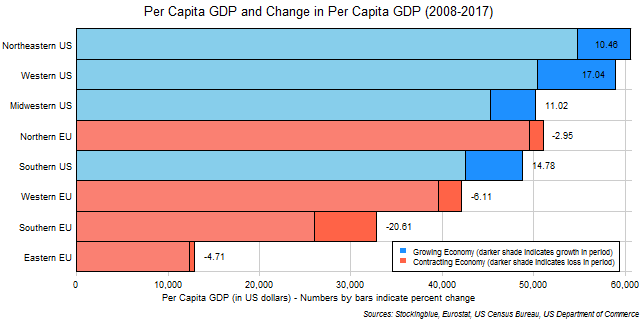
The chart above shows the per capita GDP and change in per capita GDP over the last ten years in EU and US regions in US dollars. All four EU regions experienced a contraction in per capita GDP when priced in US dollars over the past ten years. A good chunk of that contraction came from fluctuations in the values of the euro and the dollar.
Findings
- The difference between the region with the greatest absolute growth in per capita GDP, the Western US, and the region with the least, the Midwestern US, is $3,603.74.
- The Western US has 1.72 times the per capita absolute economic growth that the Midwestern US does in the past ten years.
- The difference between the region with the greatest growth rate in per capita GDP, the Western US, and the region with the least, the Northeastern US, is 6.58 percentage points.
- The Western US has 1.63 times the per capita economic growth rate that the Northeastern US does in the past ten years.
- All four EU regions saw a contraction in per capita GDP when priced in US dollars.
- The Western US and Midwestern US both overtook the Northern EU in per capita GDP when priced in US dollars in the ten year period.
Caveats
- All percentages are rounded to the nearest hundredth.
- EU and US data come from different sources.
- US data was priced in 2009 dollars while the EU data was priced in current euros so the euros were adjusted to 2009 euros using the inflation rates at RateInflation.
- EU data was converted from euros to dollars at the average 2008 0.68 euros to dollars rate and the 2017 0.88 euros to dollars rate.
- The Northeastern US consists of New York, Pennsylvania, New Jersey, Massachusetts, Maryland, Connecticut, New Hampshire, Delaware, Maine, Rhode Island, and Vermont.
- The Western US consists of California, Washington, Colorado, Arizona, Oregon, Utah, Nevada, New Mexico, Hawaii, Idaho, Alaska, Montana, and Wyoming.
- The Midwestern US consists of Illinois, Ohio, Michigan, Indiana, Minnesota, Wisconsin, Missouri, Iowa, Kansas, Nebraska, North Dakota, and South Dakota.
- The Northern EU consists of Sweden, Denmark, and Finland.
- The Southern US consists of Texas, Florida, Georgia, North Carolina, Virginia, Tennessee, Louisiana, South Carolina, Alabama, Kentucky, Oklahoma, Arkansas, Mississippi, and West Virginia.
- The Western EU consists of Germany, United Kingdom, France, Netherlands, Belgium, Austria, Ireland, and Luxembourg.
- The Southern EU consists of Italy, Spain, Portugal, Greece, Cyprus, and Malta.
- The Eastern EU consists of Poland, Czech Republic, Romania, Hungary, Slovakia, Bulgaria, Croatia, Slovenia, Lithuania, Latvia, and Estonia.
Details
Although the EU regions' per capita GDP all grew when priced in euros, their per capita GDP shrank when priced in US dollars (using the same currency allows for a better comparison between states that use different currencies - if the base currency was the euro, the US regions would have simply grown at an even faster pace).
The Western US had both the greatest growth of $8,589.16 and the greatest growth rate of 17.04% over the ten-year period.
Sources
Eurostat. 2017. "Data Explorer." Accessed December 11, 2017. http://appsso.eurostat.ec.europa.eu/nui/show.do?dataset=urb_lpop1&lang=en.
Eurostat. 2018. "Eurostat - Tables, Graphs and Maps Interface." Accessed August 2, 2018. http://appsso.eurostat.ec.europa.eu/nui/show.do?query=BOOKMARK_DS-420898_QID_-378D3319_UID_-3F171EB0&layout=TIME,C,X,0;GEO,L,Y,0;UNIT,L,Z,0;NA_ITEM,L,Z,1;INDICATORS,C,Z,2;&zSelection=DS-420898INDICATORS,OBS_FLAG;DS-420898UNIT,CP_EUR_HAB;DS-420898NA_ITEM,B1GQ;&rankName1=UNIT_1_2_-1_2&rankName2=INDICATORS_1_2_-1_2&rankName3=NA-ITEM_1_2_-1_2&rankName4=TIME_1_0_0_0&rankName5=GEO_1_2_0_1&sortC=ASC_-1_FIRST&rStp=&cStp=&rDCh=&cDCh=&rDM=true&cDM=true&footnes=false&empty=false&wai=false&time_mode=NONE&time_most_recent=false&lang=EN&cfo=%23%23%23%2C%23%23%23.%23%23%23.
United States Census Bureau. "Annual Estimates of the Resident Population: April 1, 2010 to July 1, 2016." Accessed December 12, 2017. http://factfinder2.census.gov.
US Department of Commerce. 2018. "US Bureau of Economic Analysis." Accessed June 26, 2018. https://bea.gov/itable/iTable.cfm?ReqID=70&step=1#reqid=70&step=10&isuri=1&7003=1000&7035=-1&7004=naics&7005=1&7006=01000,02000,04000,05000,06000,08000,09000,10000,11000,12000,13000,15000,16000,17000,18000,19000,20000,21000,22000,23000,24000,25000,26000,27000,28000,29000,30000,31000,32000,33000,34000,35000,36000,37000,38000,39000,40000,41000,42000,44000,45000,46000,47000,48000,49000,50000,51000,53000,54000,55000,56000&7036=-1&7001=11000&7002=1&7090=70&7007=2017,2016,2015,2014,2013,2012,2011,2010,2009,2008,2007,2006&7093=levels.